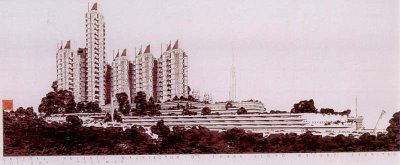[Welcome Kiwiblog, Herald and NBR readers. Please also see my more immediate reaction to National’s proposals: “Government finally plans to address unaffordable housing. But…”]
The debate over affordable housing is already being framed as a facile debate between “sprawl” and “intensification”—a debate between those who wish to release (just a little) the planners’ ring-fences around NZ’s major cities to allow new homes on “greenfield” sections, versus those who insist we build with more intensity within the ring fence on so called “brownfield” sites.
The latter group characterise the former as being in favour of “sprawl”; the former characterise the latter as promoting the construction of the slums of tomorrow.
Both are right, and both are wrong.
What’s missing here is choice. In talking about about development on either “greenfield” or “brownfield” sites, both advocates insist that folk do things their way. They completely ignore the fact that people have the right to choose where and how they live, particularly if they own the place on which they choose to settle down.
Let people live where they wish to, as long as they bear the costs. And let those choices themselves—choices based on people’s own values for which they are prepared to pay the cost—organically reflect the way the city develops.
Ironically, it’s the very promoters of intensification, the planners themselves, who have done the most to make decent intensification more difficult. Here's just some examples of a few urban housing types that are enormously popular overseas, but could barely be even contemplated here…...
- Linked home units (e.g. 'sausage' blocks)
- Semi-detached housing units
- Four-storey walk-up apartments
- Multi-storey apartments with elevators
- Community housing, with shared courtyards, shared kitchen areas and the like
- Two, three, and four-storey terrace housing
- Courtyard housing, and courtyard clusters
- Mews housing
- Mixed-use four storey walk-ups
- innovative medium-density housing (such as Rotterdam's 'pole houses,' Frank Lloyd Wright's Suntop Homesand Crystal Heights apartments, San Francisco's Fulton Grove 'alley housing,' and Moshe Safdie's Habitat)
- Single family home on an eighth-of-an-acre section
 These are only some of the many, many housing types possible that may grace a city (some pictured below), and that’s not to mention some of the other innovative types that might be dreamed up (like Moshe Safdie’s ‘Habitat’ project at left, or Rotterdam’s ‘pole houses.’)
These are only some of the many, many housing types possible that may grace a city (some pictured below), and that’s not to mention some of the other innovative types that might be dreamed up (like Moshe Safdie’s ‘Habitat’ project at left, or Rotterdam’s ‘pole houses.’)
Now, with all these types of urban housing available, most of them enormously popular overseas (and some of them once very popular here), ask yourself how many of them a land-owner would be allowed to build on his typical bit of land in a typical NZ city...
If you guessed "not many," you'd be dead right.
 The answer (with rare exceptions) is that for most bits of land in most NZ suburbs, all of the housing types listed above that make the least use of scarce urban land are allowed, and all those that help increase the number of housing units that can comfortably work in a city -- and that are enormously popular overseas -- almost all of these urban housing types are disallowed.
The answer (with rare exceptions) is that for most bits of land in most NZ suburbs, all of the housing types listed above that make the least use of scarce urban land are allowed, and all those that help increase the number of housing units that can comfortably work in a city -- and that are enormously popular overseas -- almost all of these urban housing types are disallowed.
 Is this smart, do you think? People who complain about the number of single family homes that are built on eighth-of-an-acre sections right across NZ cities (which is mostly what NZ District Plans are written to protect) should direct their ire at those who ensure this is the only thing people are allowed to build: at the planners and the Resource Management Act that gives the planners their power.
Is this smart, do you think? People who complain about the number of single family homes that are built on eighth-of-an-acre sections right across NZ cities (which is mostly what NZ District Plans are written to protect) should direct their ire at those who ensure this is the only thing people are allowed to build: at the planners and the Resource Management Act that gives the planners their power.
District Plans drawn up by planners place enormous restrictions on what one can do one one's own land, restricting choice and trampling over property rights -- but it's been going on for so long and with so little protest that most of these restrictions and the "right" of planners to impose them are simply taken for granted. 
Planners have placed restrictions on the height of what you can build, on the setbacks of new buildings from the street and from boundaries, and most importantly restrictions are place on the density of new building -- on the number of housing units one may build on one's own land.
 It is the restrictions on density that exert the biggest stranglehold on our cities. At a density similar to some of the better parts of London for example, with which many NZers are familiar, the population of Auckland could be easily fitted on the ishthmus, with plenty of land left over for parks, and plenty of land left over outside the isthmus for decreased densities if people so wish.
It is the restrictions on density that exert the biggest stranglehold on our cities. At a density similar to some of the better parts of London for example, with which many NZers are familiar, the population of Auckland could be easily fitted on the ishthmus, with plenty of land left over for parks, and plenty of land left over outside the isthmus for decreased densities if people so wish.
Instead, the planners have ensured the city spreads slowly out into the country-side one relaxation of the ring-fence after another, creating the very "carpet sprawl" that so many supporters of the Resource Management Act claim they dislike, and removing the chance of genuine country living for those who do really desire it. 
In some parts of some NZ cities, even further restrictions have been placed on land, protecting the cold and archaic early twentieth-century housing that still disgraces so much of the early urban landscape. By which I mean those dark, damp, disgusting villas which need all the villa-ness removed in order to make them liveable, but which planners have made virtually impossible to touch.
Taking the power they’ve been given under the Resource Management Act and coupling it with the Utopian dreams handed down to them in Planning School, planners have almost single-handedly stuffed up our cities and restricted the supply of urban land, making building land even scarcer than it needs to be, and restricting the housing choices that New Zealanders are allowed to make to a one-size-fits-all bland-and-blander straitjacket, making urban space duller and even scarcer still.
Why do we give these people such power?

When there's just so much available, so many great housing types from which to choose, it just doesn't make any sense.
“Sprawl” or “intensification”? That’s a false dichotomy. I say let people be free to choose.
That’s the path to genuinely liveable cities, and to affordability.

7 comments:
Perhaps not directly related to your post, but what do you think about the ideas of people like Fred Harrison when they write about the special nature of land ownership? We discussed it briefly at one of meetings at Auckland Uni, but I would very interested to know what you think about this: http://www.foldvary.net/works/geoaus.html
So "Sprawl” or “intensification” is a false dichotomy. What nonsense. You frame this agrument as a positive sum game - i.e. everyone wins - which is clearly not the case. (But then capitalist theory always tries to 'prove' that). Land is a signular use resource - if I use it for one thing, I can't use it for another. Hence, sprawl has a significantly greater impact that intensification, which is already under a specific use. Quite simply is that adding an 'extra story' to a builing - or infill housing - has less impact. It is also more efficient and effectiveness on numerous measures. With sprawl the impact are much greater - larger transport, utility costs etc. Also, what effect does the lost of production off the farmland cost the wider economy and environment. These are real costs, these are not false. Until people who support 'sprawl' can address these costs, then it is no more than a rant to justify having more property speculation.
Paul:
"Land is a signular use resource - if I use it for one thing, I can't use it for another."
The idea of opportunity cost is well known to every economist. It certainly does not follow that transactions are therefore zero-sum games.
"With sprawl the impact are much greater - larger transport, utility costs etc."
Interesting. Do you have data which shows that (1) cities with fewer land-use regulations have higher rates than those which do, and if so (2) which demonstrates a causal link between less regulation and higher rates?
Moreover, if you can prove this link, can you explain how it cannot be justified for people to move into lower-density areas, providing that they are willing to pick up the tab for these services?
"Also, what effect does the lost of production off the farmland cost the wider economy and environment."
Well, presumably the farmer believed that the net present value of the purchase was greater than the future revenue that would accrue from continuing to use the land as a farm. The wider economy has gained.
You forgot to mention that "planners" believe the RMA enables them to decide the design and look of new houses in certain areas.
Paul
You missed a key point in PC's post.
As you say, adding an extra story or infill housing has less imapct. But it is also illegal under the RMA.
It is not about sprawl (which is illegal) or intensification (which is illegal). It is about a government writing laws, telling us what we can and cannot do with our own land.
It's not just the types of dwellings allowed that are the problem but minimum parking requirements, turning circles and a myriad of other nonsense...
Oh if I was Auckland Mayor...
I can't say I agree with most of your posts but here you are bang on.
I am very pro urban and have been very frustrated with the rural based attitude of NZ towards housing. I agree the sprawl/intensification debate is meaningless. whether you think Auckland should look like Copenhagen (my choice BTW) or Houston (please no) the current rules don't allow either.
However even more important is our transport choices. Auckland won't work properly as a real city until we have a proper rail based transport system that serves the needs of the majority of Aucklanders. I believe only the CRL project can do that. you candy have a real city if the overwhelming majority of trips are made by private car. what you end up with instead is a whole lot of small disconnected towns which do t have easy access to the amenities of the city. the worst of the urban and rural worlds together.
Post a Comment